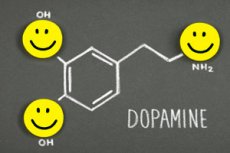New publications
Two Truths of Dopamine: Lower with Depression, Higher Symptoms - Stronger Psychosis
Last reviewed: 18.08.2025

All iLive content is medically reviewed or fact checked to ensure as much factual accuracy as possible.
We have strict sourcing guidelines and only link to reputable media sites, academic research institutions and, whenever possible, medically peer reviewed studies. Note that the numbers in parentheses ([1], [2], etc.) are clickable links to these studies.
If you feel that any of our content is inaccurate, out-of-date, or otherwise questionable, please select it and press Ctrl + Enter.

A PET study with [^18F]-DOPA in people with psychosis associated with mood disorders was published in JAMA Psychiatry. It found: (1) in patients with psychotic depression, dopamine synthesis in the striatum is lower than in mania/mixed states; (2) transdiagnostic - the higher the capacity for dopamine synthesis, the stronger the positive psychotic symptoms (delusions/hallucinations). These data reconcile the "classic" about the role of dopamine in psychosis with the clinical differences between depression and mania.
Background
- The dopamine hypothesis of psychosis is a classic with updates. Modern reviews show that in psychoses the most significant disturbance is the presynaptic function of dopamine in the striatum (increased synthesis/release), which is consistent with the effectiveness of D2 blockers. This "version III" of the hypothesis is formalized in the works of O. House and colleagues.
- What does [^18F]DOPA PET measure? This method quantifies the ability to synthesize dopamine (Kicer index) in subregions of the striatum (associative, limbic, sensorimotor) and has long been used to study psychosis and predict response to therapy.
- Previously, increased dopamine synthesis was repeatedly found in people with a first episode of psychosis and in some patients with bipolar psychosis; the severity of positive symptoms (delusions/hallucinations) correlated with the Kicer value, especially in the association striatum.
- Gap: How the dopamine “signature” changes in affective psychoses – depression with psychotic symptoms vs. mania/mixed states – and whether the “more dopamine → more psychosis” link persists across diagnoses, remained unclear.
- Why the current study is needed (JAMA Psychiatry, August 2025). The authors compared Kicer in 76 people (38 with affective psychoses: 25 - depression + psychosis; 13 - mania/mixed; 38 healthy) and tested the transdiagnostic relationship with the severity of positive symptoms. According to the Imperial College press release of August 13, 2025: regardless of nosology, higher dopamine synthesis is associated with more severe positive symptoms, while in psychotic depression synthesis is on average lower than in mania.
- Practical context: If biomarkers of dopamine dysregulation do reflect the severity of psychosis across diagnoses, this would argue for stratification of treatment (including choice of dopamine-modulating strategies) by neurobiology rather than clinical label alone. This approach has been discussed as a way to personalize psychosis treatment.
What did they do?
- A total of 76 subjects were prospectively compared: 38 patients with psychosis and severe mood symptoms (25 - depressive episode; 13 - mania/mixed) and 38 healthy controls. Dopamine synthesis was assessed in three striatal subregions (associative, limbic, sensorimotor) using [^18F]-DOPA PET. The severity of psychotic symptoms was measured in parallel.
Main results
- Depression + psychosis: the dopamine synthesis rate (Kicer) is lower than in psychosis against the background of mania/mixed episode.
- Association with symptoms (across diagnoses): in the pooled psychosis sample, higher Kicer ↔ more positive symptoms (explains part of the variance in severity). This supports a transdiagnostic role for dopamine dysregulation in psychosis.
- Regional specificity: Key effects were found in the association striatum, an area previously linked to psychosis.
Why is this important?
- Historically, PET studies have shown increased dopamine synthesis in schizophrenia and bipolar disorder, which formed the basis of the “dopamine hypothesis” of psychosis. The new paper clarifies the picture: dopamine levels vary depending on the affective state, but its relationship with the severity of psychosis remains across nosologies.
What this might mean for practice
- Depressed patients with psychotic symptoms have traditionally been less likely to receive treatments that directly target dopamine. The results suggest that some of this group may benefit from dopamine-modulating approaches - especially if biomarkers show high synthesis. Personalization by biomarkers, not just by diagnostic label, is needed.
- For drug development: association striatum remains a priority target; PET biomarkers like Kicer may serve as stratification in trials.
Context and novelty
- The work develops a line of research by the same group, which showed that increased dopamine synthesis occurs in psychosis in different diagnoses (schizophrenia, bipolar psychosis). The current study adds a mood dimension and breaks down the differences between depression and mania/mixed states.
Restrictions
- The sample size is moderate (n=76) and the design is cross-sectional: causality cannot be proven.
- [^18F]-DOPA PET measures presynaptic synthesis rather than the entire dopamine transmission chain; clinical translation requires caution.
- Replications in larger cohorts and trials using PET biomarkers to guide therapy selection are needed.
Source: Sameer Jauhar et al., JAMA Psychiatry (online, August 2025) - “Dopamine and Mood in Psychotic Disorders: An [^18F]-DOPA PET Study”; Imperial College London press release. doi: 10.1001/jamapsychiatry.2025.1811
